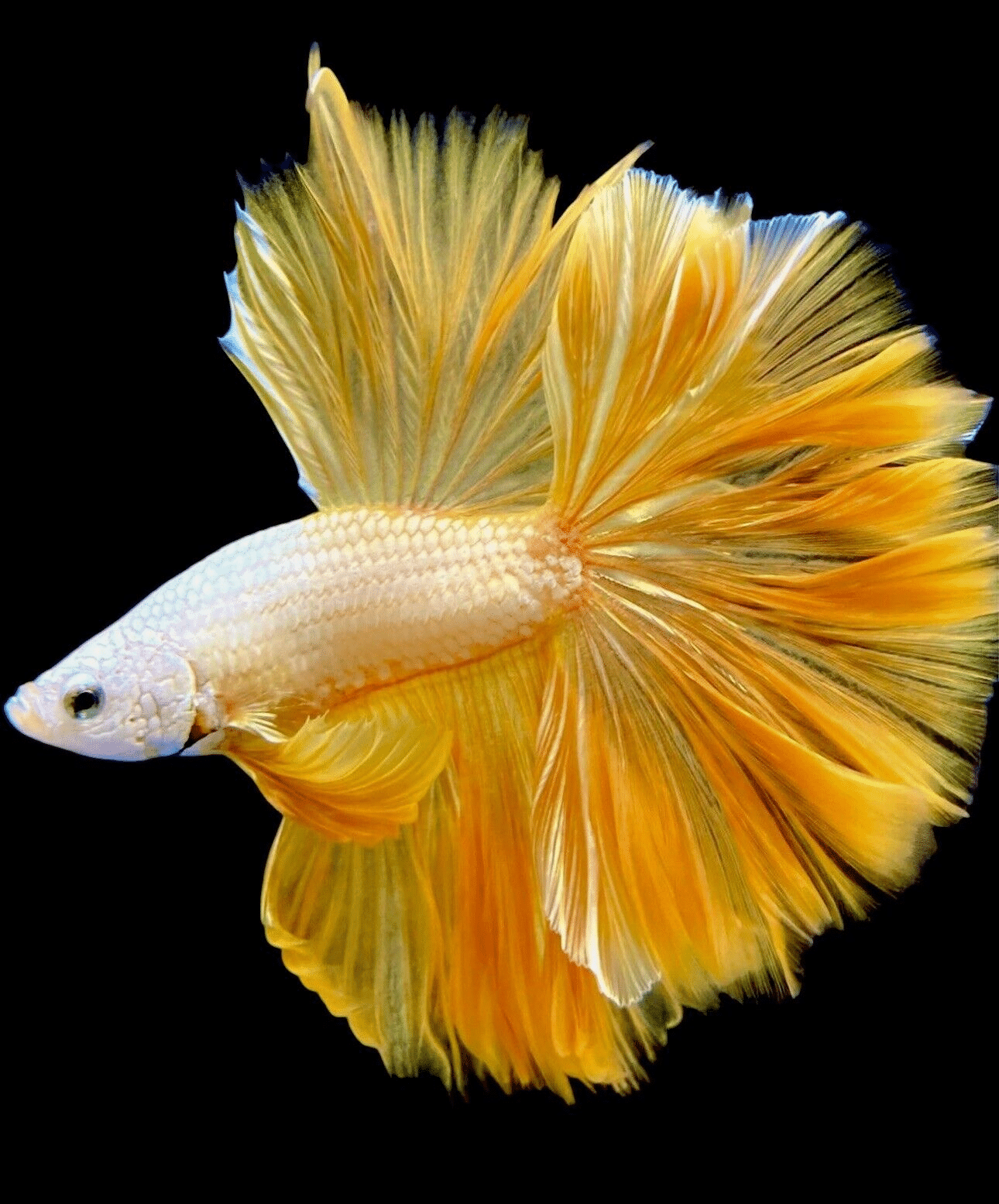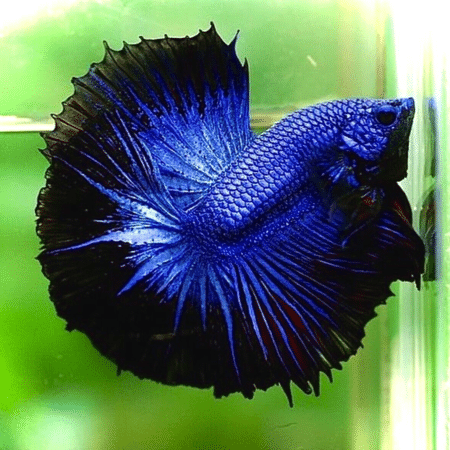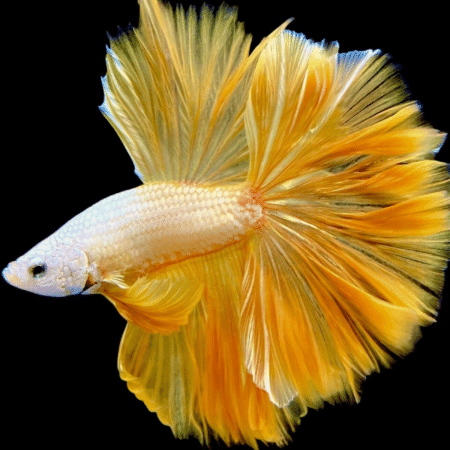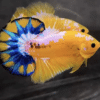STUNNING HALFMOON MALE RANDOMLY SELECTED SPLEND BEAUTIFUL BETTA FISH FIGHTER, A Stunning Betta splendens Companion for Your Aquarium, Perfect for Beginners to Care For, Easy Care Betta for New Aquarists
£18.49 Original price was: £18.49.£15.48Current price is: £15.48.
Welcome this stunning Halfmoon Male Betta Fish into your aquarium. Known for their vibrant colors and graceful movements, these Betta splendens are perfect for aquarists seeking elegant companions. Provide a loving home for these peaceful fish and enjoy their beauty in your fish tank.
996 in stock
Species Introduction
The Halfmoon Male Betta Fish, scientifically known as Betta splendens, is a captivating species that originates from the shallow waters of Southeast Asia, particularly in regions of Thailand, Cambodia, and Vietnam. This species thrives in slow-moving waters such as rice paddies, ponds, and marshes, where they can display their vibrant colors and elegant fins. The Halfmoon variety is particularly noted for its stunning tail structure, which forms a semi-circle when fully spread, resembling the shape of a half moon. These beautiful aquatic companions are well-loved by aquarium enthusiasts for their striking appearance and relatively easy care requirements, making them suitable for both beginners and experienced aquarists alike.
Care Requirements Dashboard
Essential Care Guide for Your Halfmoon Male Betta Fish
| Optimal Living Conditions | |
|---|---|
| Water Temperature | 24-27°C (75-81°F) |
| pH Level | 6.5-7.5 |
| Water Hardness | 4-12 dKH |
| Minimum Tank Size | 80L (20 gal) |
| Salinity | Freshwater |
| Care Level | Beginner Friendly |
.care-requirements-dashboard {
background: linear-gradient(135deg, #e3f2fd 0%, #f1f8e9 100%);
padding: 20px;
border-radius: 12px;
margin: 20px 0;
box-shadow: 0 4px 6px rgba(0,0,0,0.1);
}
.aquarium-info-table {
width: 100%;
border-collapse: collapse;
background: white;
border-radius: 8px;
overflow: hidden;
margin-top: 15px;
}
.table-header-primary {
background: linear-gradient(135deg, #2196F3, #1976D2);
color: white;
font-weight: bold;
padding: 15px;
text-align: center;
}
.table-row-even {
background-color: #f8f9fa;
}
.table-row-odd {
background-color: white;
}
aquarium-info-table td {
padding: 12px 15px;
border-bottom: 1px solid #e0e0e0;
}
.highlight-important {
font-weight: bold;
color: #1976D2;
}
.care-level-indicator.beginner {
background: #4CAF50;
color: white;
padding: 4px 12px;
border-radius: 16px;
font-size: 0.9em;
}
Natural Behavior & Temperament
The Halfmoon Male Betta Fish is known for its vibrant personality and dynamic behavior. Typically, these fish exhibit a curious and active nature, often exploring their surroundings within the aquarium. They are territorial by nature, especially males, and will display aggressive behaviors towards other males of the same species. However, they can coexist peacefully with certain community fish, provided that their tank mates are not overly aggressive or fin nippers. Betta fish are also known for their unique bubble-nesting behavior during breeding, where males create a nest of bubbles on the water’s surface to protect their eggs. Understanding their natural behavior is essential for creating an environment that mimics their native habitat and promotes their well-being.
Tank Setup Guide
Creating an ideal environment for your Halfmoon Male Betta Fish is crucial for their health and happiness. The tank should be a minimum of 5 gallons to provide ample swimming space and to maintain stable water parameters. A soft substrate, such as sand or fine gravel, is recommended to prevent injury to their delicate fins. Include plenty of hiding spots using decorations like caves, driftwood, and live or silk plants, which also help mimic their natural habitat. Ensure that the tank has a secure lid, as Betta fish are known to jump. Additionally, a gentle filter is necessary to maintain water quality, but avoid strong currents that can stress these fish. Lighting should be moderate, with a day/night cycle to simulate their natural environment.
Water Quality Management
Good Water Quality is Essential
Maintaining optimal water quality is vital for the health of your Halfmoon Male Betta Fish. Regular testing of water parameters, including pH, ammonia, nitrite, and nitrate levels, is essential. The pH should be kept between 6.5 and 7.5, with a temperature range of 76°F to 82°F. Weekly water changes of 25-50% are recommended to ensure clean and healthy water. Use a water conditioner to remove harmful chemicals such as chlorine and chloramine from tap water before adding it to the tank. Monitoring water hardness is also important, with a range of 5 to 20 dGH being ideal. Keeping the aquarium clean and well-maintained will significantly contribute to the overall well-being of your Betta fish.
Feeding & Nutrition
Feeding your Halfmoon Male Betta Fish a balanced diet is crucial for their health and vibrant coloration. These fish are carnivorous and thrive on a diet rich in protein. High-quality Betta pellets, frozen or freeze-dried foods such as bloodworms, brine shrimp, and daphnia should be included in their diet. It is important to feed them small amounts 2-3 times a day, ensuring that they consume all food within a few minutes to prevent water quality issues. Overfeeding can lead to obesity and other health problems, so moderation is key. Additionally, providing occasional vegetable matter, such as blanched peas or spinach, can aid in digestion and overall health. A well-rounded diet will not only keep your Betta fish healthy but will also enhance their natural beauty.
Compatibility Guide
Peaceful Tank Mates
| Compatible Fish | Notes |
|---|---|
| Neon Tetras | Small, peaceful schooling fish. |
| Corydoras Catfish | Bottom dwellers that are non-aggressive. |
| Guppies | Colorful and peaceful companions. |
| Rasboras | Active schooling fish that get along well. |
Health & Wellness
Maintaining the health of your Halfmoon Male Betta Fish involves regular monitoring for signs of illness and stress. Common health issues include fin rot, ich, and velvet disease, which can be prevented through proper water quality management and a balanced diet. Observing your Betta for any changes in behavior, such as lethargy, loss of appetite, or abnormal swimming patterns, is essential for early detection of health problems. Additionally, providing a stress-free environment with hiding spots and appropriate tank mates can significantly enhance their well-being. If health issues arise, prompt treatment with appropriate medications and careful monitoring can help restore your Betta’s health.
Breeding Information
Breeding Tips
Breeding Halfmoon Male Betta Fish can be a rewarding experience, but it requires careful preparation and knowledge of their reproductive behaviors. Males will build a bubble nest on the water’s surface, which is essential for spawning. To initiate breeding, introduce a female Betta into the male’s territory after ensuring both are healthy and well-fed. Once spawning occurs, the male will wrap around the female, fertilizing the eggs as they are released. After spawning, the female should be removed to prevent aggression from the male. The male will care for the eggs, which will hatch in about 24-36 hours. Once the fry are free-swimming, they can be fed infusoria or finely crushed flakes until they are large enough for larger foods. Proper care during this stage is critical for fry survival.
Acclimation Process
Acclimating your Halfmoon Male Betta Fish to a new tank is crucial to ensure a smooth transition and reduce stress. Begin by floating the sealed bag containing the Betta in the aquarium for about 15-20 minutes to equalize the temperature. After this, gradually introduce small amounts of tank water into the bag every 5-10 minutes for about an hour. This process helps the Betta adjust to the water parameters of the new environment. Once acclimated, gently release the Betta into the tank using a net to avoid introducing any contaminants from the bag. Monitoring the Betta for signs of stress or aggression after introduction is essential, and providing a quiet, dimly lit area can help them settle in more comfortably.
Long-term Care
The lifespan of a Halfmoon Male Betta Fish can range from 3 to 5 years, depending on the quality of care provided. As they age, it is important to continue monitoring their health and adjusting their diet as needed. Regular water changes and tank maintenance will help prevent diseases and ensure a thriving environment. Additionally, as Betta fish can become more territorial with age, providing ample space and hiding spots is essential to reduce stress and aggression. Keeping a close eye on their behavior and physical condition will allow you to address any potential issues promptly, ensuring a long and healthy life for your aquatic companion.
Natural Habitat Recreation
Biotope Setup
To create a natural habitat for your Halfmoon Male Betta Fish, consider replicating their native environment found in Southeast Asia. This can be achieved by using natural materials such as driftwood, smooth stones, and live plants like Java fern or Anubias. These elements provide hiding spots and mimic the shallow waters they inhabit. Additionally, maintaining a slightly dim lighting setup can help recreate the natural conditions of their habitat. Incorporating floating plants can also provide shade and security for your Betta, making them feel more at home. A well-planned biotope setup not only enhances the aesthetic appeal of your aquarium but also promotes the overall health and well-being of your Betta fish.
Seasonal Care Adjustments
As seasons change, so do the needs of your Halfmoon Male Betta Fish. During warmer months, ensure that the water temperature does not exceed 82°F, as higher temperatures can lead to stress and health issues. Consider using a fan or air conditioning to maintain a stable environment. In colder months, a heater may be necessary to keep the water temperature within the ideal range. Additionally, adjusting the lighting duration to mimic natural day/night cycles can help regulate their behavior and promote a healthy lifestyle. Regularly checking water parameters during seasonal changes is essential to ensure a stable and healthy environment for your Betta fish.
Expert Tips
Professional Advice
To ensure the best care for your Halfmoon Male Betta Fish, consider these expert tips: First, always observe your Betta’s behavior closely; any changes can be an early sign of stress or illness. Second, avoid keeping Betta fish in bowls or small tanks, as these environments can lead to poor water quality and stress. Third, consider using a sponge filter to maintain gentle water movement while providing adequate filtration. Lastly, engage with your Betta through interaction; they are known to recognize their caretakers and may respond positively to gentle movements or feeding routines. These practices will help you create a nurturing environment for your aquatic friend.
Troubleshooting
If you encounter issues with your Halfmoon Male Betta Fish, identifying the problem quickly is crucial. Common issues include fin rot, which can be treated by improving water quality and using medications specifically designed for fin rot. If your Betta is displaying signs of stress, such as rapid gill movement or hiding excessively, check the water parameters immediately. Poor water quality is often the culprit. In cases of aggression or fin nipping, consider rearranging the tank or providing additional hiding spots to reduce territorial disputes. Being proactive in addressing these issues can significantly improve your Betta’s quality of life.
Scientific Background
Taxonomy and Conservation
The Halfmoon Male Betta Fish belongs to the family Osphronemidae, which encompasses various species known for their labyrinth organ that allows them to breathe atmospheric oxygen. This adaptation is particularly advantageous in their native habitats, where oxygen levels can be low. Unfortunately, habitat destruction and over-collection for the aquarium trade pose significant threats to wild Betta populations. Conservation efforts are essential to protect their natural habitats and ensure the sustainability of this beautiful species. Understanding the scientific background of your Betta fish not only enhances your appreciation but also highlights the importance of responsible care and conservation.
Advanced Care Techniques
For those looking to provide exceptional care for their Halfmoon Male Betta Fish, consider implementing advanced techniques such as creating a breeding setup that includes a separate breeding tank with optimal conditions for spawning. Additionally, utilizing live foods can enhance their diet and promote vibrant colors. Regularly engaging in water testing and adjusting parameters as needed will ensure a stable environment. Moreover, learning about and recognizing the signs of stress and illness can help you take swift action to maintain your Betta’s health. By investing time and effort into advanced care techniques, you can foster a thriving and beautiful aquatic environment for your Betta fish.
Water Quality Parameters
Optimal Range
24-27°C
6.5-7.5
0 ppm
Caution Zone
22-24°C or 27-29°C
6.0-6.5 or 7.5-8.0
0.25-0.5 ppm
Danger Zone
<22°C or >29°C
<6.0 or >8.0
>0.5 ppm
Monitoring Tip: Test water parameters weekly and perform regular water changes to maintain optimal conditions for your aquatic friends!
.water-parameters-chart {
background: linear-gradient(135deg, #e3f2fd 0%, #e8f5e8 100%);
padding: 20px;
border-radius: 12px;
margin: 20px 0;
}
.parameters-grid {
display: grid;
grid-template-columns: repeat(auto-fit, minmax(250px, 1fr));
gap: 15px;
margin: 20px 0;
}
.parameter-card {
padding: 15px;
border-radius: 8px;
box-shadow: 0 2px 4px rgba(0,0,0,0.1);
}
.parameter-card.optimal {
background: #e8f5e8;
border: 2px solid #4CAF50;
}
.parameter-card.warning {
background: #fff3e0;
border: 2px solid #ff9800;
}
.parameter-card.danger {
background: #ffebee;
border: 2px solid #f44336;
}
.parameter {
display: flex;
justify-content: space-between;
padding: 5px 0;
border-bottom: 1px solid rgba(0,0,0,0.1);
}
.parameter:last-child {
border-bottom: none;
}
.monitoring-note {
background: white;
border: 1px solid #2196F3;
border-radius: 8px;
padding: 15px;
margin-top: 20px;
}
Frequently Asked Questions
Q: What tank size is required for a Stunning Halfmoon Male Betta?
For a Stunning Halfmoon Male Betta, a minimum tank size of 20 litres is recommended. This allows sufficient space for swimming and reduces stress. Bettas are territorial and benefit from having their own space to establish a territory. A larger tank also helps maintain stable water parameters, which is crucial for their health. When setting up the tank, ensure there are hiding spots, such as plants or decorations, to provide comfort. Regular water changes of about 25% weekly will further promote a healthy environment.
✓ Expert Tip
Consider using a sponge filter to maintain water quality without creating strong currents that could stress your Betta.
Q: What water parameters do Betta fish require?
Bettas thrive in water with a temperature between 24-28°C, a pH level of 6.5 to 7.5, and a hardness of 5-20 dGH. Regular testing of these parameters is vital to ensure a stable environment. Sudden fluctuations can lead to stress and health issues. Using a quality aquarium heater and thermometer will help maintain the ideal temperature. Additionally, consider using a water conditioner to remove harmful chemicals from tap water before introducing it to the tank.
✓ Expert Tip
Using a quality water test kit allows you to monitor parameters effectively and make necessary adjustments.
Q: How often should I feed my Betta fish?
Feed your Betta fish twice a day, providing only what they can consume in 2-3 minutes to prevent overfeeding and water quality issues. A varied diet is essential, including high-quality pellets, freeze-dried or frozen foods like bloodworms, and brine shrimp. Ensure that the food is specifically designed for Betta fish, as their nutritional needs are different from other species. Monitor their behaviour to ensure they are eating well and adjust feeding quantities accordingly.
✓ Expert Tip
Soaking pellets in water before feeding can help them expand and be easier for your Betta to digest.
Q: What are the best tank mates for Betta fish?
When considering tank mates for your Betta, choose species that are peaceful and non-aggressive. Good options include snails, certain species of shrimp (like Amano shrimp), and small schooling fish such as neon tetras or rasboras. Avoid keeping them with fin-nipping fish, other male Bettas, or overly aggressive species, as this can lead to stress or injury. Always monitor interactions closely when introducing new tank mates and be prepared to separate them if necessary.
✓ Expert Tip
Adding plants and decorations can help create hiding spots, making your Betta feel more secure.
Q: How do I properly acclimatise my Betta to my aquarium?
To acclimatise your Betta, float the sealed bag containing the fish in your aquarium for about 15-20 minutes. This allows the water temperature to equalise. After that, gradually introduce aquarium water into the bag by adding a small amount every 5-10 minutes. After an hour, gently release the Betta into the tank, avoiding adding the bag water. This slow acclimatisation process reduces stress and helps your Betta adjust to its new environment more comfortably.
✓ Expert Tip
Consider using a drip acclimatisation method for more sensitive fish, which allows for a gradual transition.
Q: What are the signs of a healthy Betta fish?
A healthy Betta will display vibrant colours, active swimming behaviour, and will show interest in food. Its fins should be fully extended and free of tears or fraying. Monitor for signs of stress, such as hiding frequently, lethargy, or loss of appetite, which may indicate poor water conditions or health issues. Regular observation and maintaining optimal tank conditions are crucial for ensuring your Betta remains healthy and happy.
✓ Expert Tip
Keep a journal of your Betta’s behaviours and health to help identify any changes over time.
Q: What temperature should I maintain for my Betta?
The ideal temperature for a Betta fish is between 24-28°C. This range promotes optimal metabolism and activity levels. Fluctuations outside this range can lead to stress and health complications. It is advisable to invest in a reliable aquarium heater and thermometer to maintain a consistent temperature. Regular monitoring is essential, especially during seasonal changes, to ensure your Betta remains in a comfortable and healthy environment.
✓ Expert Tip
Position the heater near a filter outlet to ensure even distribution of warm water throughout the tank.
Q: How long do Betta fish typically live in captivity?
In captivity, Betta fish can live anywhere from 3 to 5 years, with proper care and optimal conditions. Factors influencing their lifespan include water quality, diet, and tank environment. Regular maintenance, including water changes and monitoring for diseases, can significantly enhance their quality of life. Providing a stress-free environment and appropriate tank mates will also contribute to their longevity.
✓ Expert Tip
Consider keeping a log of your Betta’s health and behaviours to track their well-being over time.
Q: What type of substrate is most suitable for Betta fish?
For Bettas, a substrate that is smooth and soft is ideal to prevent injury to their delicate fins. Fine gravel or sand are excellent choices, as they allow for easy cleaning and do not trap debris. Additionally, if you plan to plant live plants, ensure that the substrate is nutrient-rich to support their growth. Avoid sharp or rough substrates, as these can cause damage to your Betta’s fins and overall health.
✓ Expert Tip
Consider adding plants or decorations to provide a more natural environment, which Bettas appreciate.
Q: What behavioural patterns should I expect from my Betta fish?
Bettas are known for their vibrant personalities. They may exhibit territorial behaviour, especially when encountering their reflection or other males. You can expect them to swim around their tank, exploring their environment, and they often display bubble nesting behaviour when ready to breed. Bettas can also show signs of curiosity and may interact with their aquarium keeper. Regular interaction can build trust and reduce stress.
✓ Expert Tip
Provide visual barriers, like plants, to reduce stress from territorial disputes.
Q: How can I prevent common diseases in Betta fish?
To prevent diseases, maintain excellent water quality through regular testing and changes, and ensure your Betta is not stressed. Quarantine new fish before introducing them to the main tank to prevent disease transmission. A varied diet rich in nutrients will also enhance their immune system. Regular observation of your Betta’s behaviour and appearance will help you spot any signs of illness early. Prompt action can often prevent a minor issue from becoming severe.
✓ Expert Tip
Introduce aquarium salt as a preventive measure, but use it cautiously and not on sensitive species.
Q: What lighting conditions do Betta fish prefer?
Bettas prefer moderate lighting conditions. Bright, harsh light can cause stress, so it is advisable to provide shaded areas using floating plants or decorations. A standard aquarium light on a timer for 8-10 hours a day mimics their natural habitat and promotes healthy plant growth. Observe your Betta’s behaviour; if they appear to hide frequently, consider adjusting the lighting to create a more comfortable environment.
✓ Expert Tip
Using LED lights allows for energy efficiency and can enhance the colours of your Betta.
Q: How do I recognise stress in my Betta fish?
Signs of stress in a Betta fish may include hiding, lethargy, loss of appetite, and fin clamping. They may also exhibit rapid gill movement or swim erratically. It is essential to monitor your Betta regularly and maintain stable water parameters. If you notice these signs, investigate potential stressors, such as poor water quality, aggressive tank mates, or environmental changes. Addressing the underlying issues promptly will help restore your Betta’s health and behaviour.
✓ Expert Tip
Creating a calm and stable environment is crucial for reducing stress in Betta fish.
Q: What natural habitat conditions should I replicate for Betta fish?
Bettas are native to shallow waters in Southeast Asia, often found in rice paddies and slow-moving streams. To replicate their natural habitat, provide a well-planted tank with plenty of hiding spots using driftwood or rocks. The water should be warm, slightly acidic, and rich in organic material. Mimicking these conditions will help your Betta feel secure and thrive. Additionally, consider using floating plants to create a shaded area, which is a characteristic of their natural environment.
✓ Expert Tip
Researching the natural habitat of Bettas can provide insights into creating a suitable environment.


















Emily Carter (verified owner) –
I recently purchased the ‘Stunning Halfmoon Male Betta Fish’ and I couldn’t be more thrilled! As a caring fish parent, I understand the importance of choosing the right fish for my aquarium, and this betta has exceeded my expectations. Its vibrant colors and flowing fins are truly breathtaking. After two weeks of adapting to its new home, I’ve noticed such a lively personality. It flares beautifully at the slightest movement, which adds so much character to my tank!
What really sets this fish apart from others I’ve had is its apparent health. It arrived with clear fins, vibrant colors, and an active demeanor, which I attribute to the great care taken in its shipping process. My previous bettas seemed more prone to stress and illness, but this one appears genuinely happy and healthy.
I would highly recommend this betta to both new and experienced aquarists who appreciate a stunning fish that enhances any tank. Just be mindful of their temperamental nature; a smaller tank is best to avoid overwhelming them. Overall, this purchase has been a delight, and I’m looking forward to seeing how it grows! Would definitely buy again!